Our ‘dining room voyages’ begin with mint tea – thanks to Morocco and its famous tea culture. We drink our Nigerian version, out of a rather English teapot from Turkish tulip glasses – evidence of our global identity. We love it.
Mint is somewhat vital to our family’s happiness. For months, our garden blooms with its bright green leaves. Then we drink and eat the leaves and when our growing season is past, the D-Line street market, known as Port Harcourt’s ‘Fruit Garden’ serves us well.
It wasn’t always so – I grew up on good ole English tea. My first encounter with mint tea was years ago at Levant, a Middle Eastern basement restaurant in the heart of London.
I descended into the embrace of walls bathed in geometric patterns from exquisite lamps.
I was attending a lunch party where a spread awaited – pillowy pita breads, dips of roasted red peppers and chickpeas and skewered meats. But it was the theatre of the tea service that had me – a Moroccan tea server lifted his teapot a foot high, while holding an ornate metal tray with small glasses and spilled nary a drop – I was intrigued and bowled over with the delicious tea.
The view from Fez (comments from a blog post on ‘How to make Moroccan mint tea’)
Debbie said…
Just got back from Morocco and drank a lot of mint tea during my stay. It was always served with a couple of fresh mint leaves lining the glass, which I thought made the look and smell of the drink extra special. Is this something that is done in restaurants more often than in homes?
Alaska said…
Debbie, putting leaves in the glass itself is more of a restaurant thing. In homes, you really just end up with the bits that makes their way through the spout.
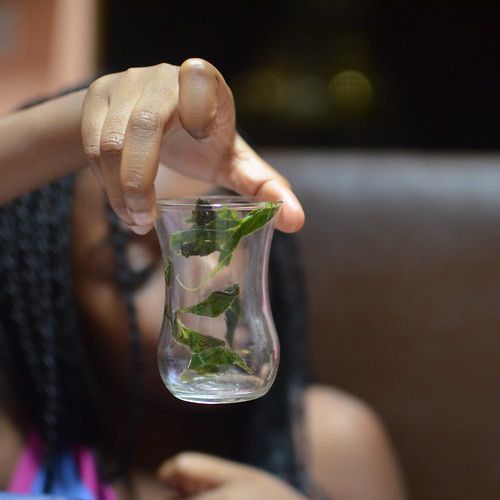
Then a lesson from Mohand, a Moroccan friend showed me that real mint tea, atay bi na’na’ was more than an infusion of leaves. His tea began with Chinese green tea, ‘Special Gunpowder’ and ended sweet and aromatic accompanied by crumbly, almond cookies that made me swoon.
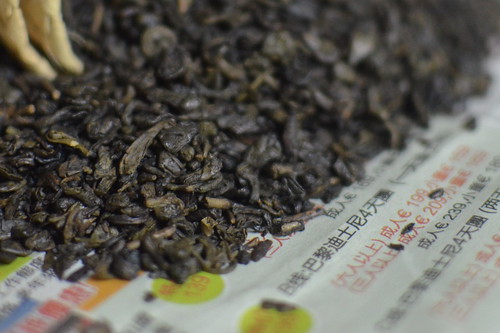
John Griffiths writes about mint tea in his book, ‘Tea: The Drink that changed the world’ (2007). Apparently, in 1854, British cargo ships loaded with Chinese green tea bound for Scandinavia and the Baltic States weren’t allowed to dock. The ships made it to the Mediterranean, where enterprising Moroccan merchants bought the entire shipment of tiny pellets of Chinese Gunpowder Green tea, hence the mint tea we know today.
It is interesting that outside of China, the Maghreb and Sahel regions drink the most green tea. (Like outside of Dublin, Nigerians drink the most Guinness stout.)
For this is tea with ‘presence’ and an assertive, flavour that complements mint’s herbaceousness.
It is tea that makes itself likeable, loveable even, and easy to drink.
Gunpowder tea is a classic green tea from the Zhejiang province, China. Near Shanghai.
This famous, non-fermented traditional Chinese tea takes its name from its resemblance to gunpowder. The leaves are hand-rolled into tiny pellets before drying. This apparently preserves a fresher aroma and flavour for the tea-drinker. The flavour is robust, smooth and a touch smoky from the ‘firing’ that occurs as soon as the leaves are plucked. They are placed and heated in iron pans for a couple of minutes over a charcoal fire, before being robbed and rolled, then fired again for a couple of hours.
The finest green teas are fanned for an hour, during the second firing process – this preserves their green hue.
The tea leaves are separated and sorted by size with the smallest sized pellets called ‘Gunpowder’ and sometimes, “green pearls”. For the third time, the gunpowder pellets are fired for 12 – 14 hours.
This evening, we are headed on a culinary excursion, further into geography and history. There is a framed world map in our living room and I’ve been praying that ‘by its mere presence’ our children will absorb world geography as they journey into adulthood.
It is Tom Hirschfeld who has planted this seed. In ‘Moving Forward’, an article in his ‘Sunday Dinners’ column on online site, Food52.com, this father and passionate home cook writes about hopes and disappointments…and a great resolve to forge ahead in the New Year. He writes ‘…I think to myself, why not add only positive things to my life this year? Like what I am going to call New Food Tuesday, where our family makes a dinner with foods we have never tried, presumably something from a different culture so when we are sitting at the table we can have conversations about different countries and how not everyone in this world is exactly the same. How these differences aren’t something to be afraid of, but should be embraced.’
Linda, a reader responds and adds geographical dimension. She says ‘… When I was little, my Dad would put a piece of paper on our Sunday breakfast plate with numbers on them. Minutes and degrees, latitude and longitude. We all ran to the globe trying to figure out the secret destination for the week and would talk about it at brunch. I loved that.’
By the time I’m done reading this exchange, I know we will begin ‘New Food …day’ for the lure of both food and culture is strong. It is what lies beyond cardinal points and co-ordinate systems, landmasses and oceans. I’m excited, to embrace home and ‘abroad’, for there is still a lot to learn about where we are, and are from – Nigeria.
But tonight, we begin with Morocco. I tell the children ‘our’ plan. We’ll travel by ‘plate’ around the world. We get to feast on a country’s cuisine but two things have to happen: we will locate the country on our map, then find and share one fact about it. In excitement, we all agree.
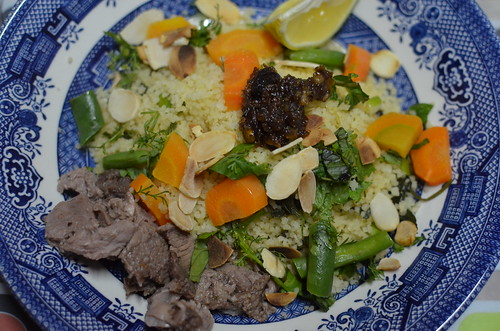
Jedidiah, my 9-year old daughter wants to know if it snows in Morocco and she finds out it does. My 7-year old daughter, Riobo wonders how mint tea became the drink of choice in Morocco and I tell her mint grows there a lot, but also about how green tea came into the picture. We have this discussion in front of the map, tracing the routes from Scandinavia to Britain and down to Morocco. Thank you, John Griffiths.
5-year old Danny boy wants to know what sports they play and discovers that football is a favourite. My husband is away so nothing to say……and I am interested in the tea traditions – I learn that serving tea is a male affair!
I don’t want to be rigid about this culinary travels and I don’t always want to start in the kitchen. I want to approach some journeys from the map, and learn and not let the contents of the refrigerator determine where we go.
This time though, half a leg of roasted lamb, a long untouched jar of couscous in the cupboard and lots of cilantro (coriander leaves) and mint scream ‘Morocco’.
The one challenge is serving couscous to the children who’ve never tried it. Once I ‘sell’ it as being ‘kind’ of like rice, they’re excited, to my surprise.
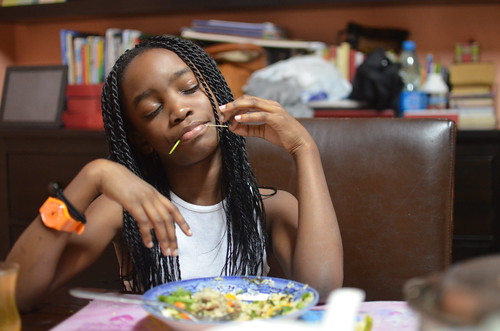
I make the tea – warming the pot with freshly boiled water. I substitute a green teabag for the gunpowder tea (which I don’t have that evening), add a handful of clean, fresh mint leaves which have been bruised by rubbing them in the palms of my hands, 4-5 whole cloves, some white sugar and freshly-boiled water. A few minutes later and tea is served.
I know this isn’t authentic Morocco, where the green tea pellets are rinsed with boiling water (thought to refine the taste of the tea), before being boiled for a few minutes, to which sugar and mint leaves are added and stirred in a long spouted teapot before decanting into small glasses.
Still, we are excited……..
At the table, everyone (some with help) takes turns to pour the tea …from on high, so it aerates and foams in the cups. Needless to say, there are some spills, which are mopped up.
These days, fresh from Edinburgh and a visit to a wonderful Chinese shop on Leith Walk, I have in my possession several packs of Chinese Gunpowder tea. And boy, is this version of mint tea wonderful. The Chinese Gunpowder tea is light and delicate, and a wonderful companion to the freshness of the mint.
Still, we’re not in Morocco, or drinking with the ‘right’ cups. Sigh. Still even, the ‘true’ way of making the mint tea, which involves boiling the mint leaves and the green tea leaves doesn’t appeal to me as much as just brewing it in a teapot.
Some day, all that will change. We will visit a tea house in Morocco, where we will sit excitedly and watch a server pour tea from a berrad (teapot) into our keesan (tea glasses) on a senia (tea-serving platter of wood, plastic, or very ornate brass or copper). We will sample local pastries and cookies, and we will experience the aroma of real atay bi na’na.
But at dinner that night and every other time since, we do the very Moroccan thing, with ease – drink at least two cups each, for the Moroccans say “The first glass is as bitter as life, the second glass is as strong as love, the third glass is as gentle as death” .
Vive la Morocco.
Moroccan Mint Tea
Ingredients
1 heaped teaspoon Chinese gunpowder tea, or 1 green teabag 3 – 6 whole cloves (or cardamom pods or whole black peppercorns, lightly crushed) A full hand of fresh spearmint leaves and stems, washed White, caster sugarFreshly boiled hot water
At home, we make mint tea two ways, depending on what is available. I’ll describe both ways.
Directions
To begin, warm the teapot by swirling a small amount of hot water in the pot, and then discarding.
Version #1: Using Gunpowder tea leaves
Bring a litre of water to the boil.
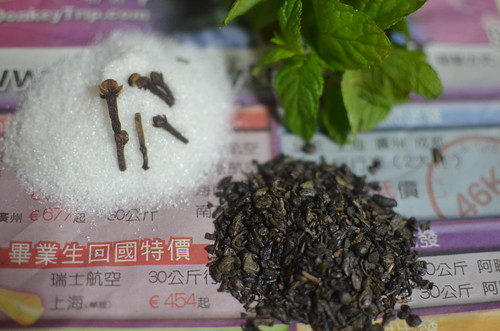
Once boiled, add a cup of the just boiled water to a Moroccan teapot or a cooking pot, if you don’t have one. To this, add the teaspoon of gunpowder tea and let sit for 30 seconds to a minute, without stirring so it the water takes on the essence of the tea leaves. Not stirring keeps the colour of the tea ‘clean’ and not murky. Strain the ‘tea’ into a cup and set aside, leaving the leaves in the pot. According to the Moroccans, this first cup contains the ‘soul’ flavour.
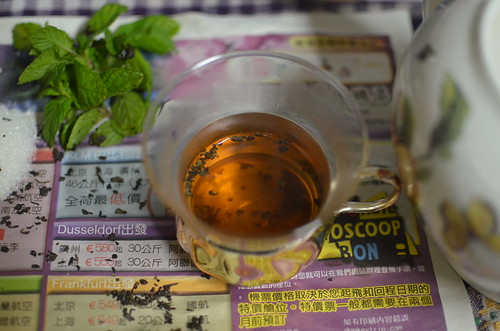
Another cup of boiling water is added to the pot with the leaves, swirled around and this time the resulting murky tea is discarded.
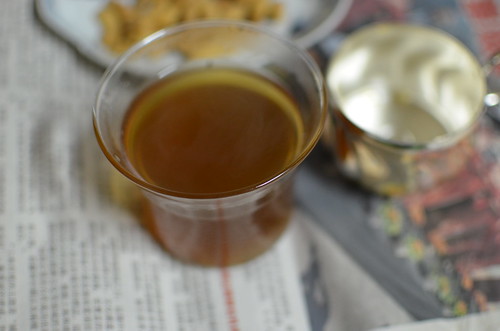
To the tea pot, add a large bunch of mint leaves which I like to bruise before I add. Follow this with 2 tablespoons of sugar. The sugar measurement is a guide – adjust to your peculiar particular taste.
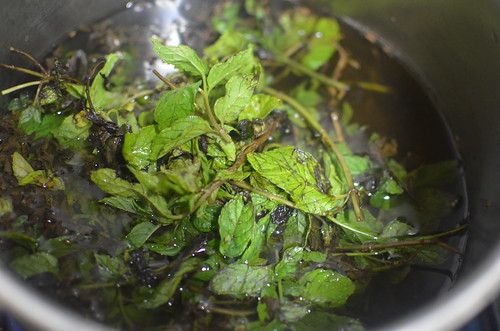
Pour the reserved cup of tea, from the very first step, top up with water, about 3 – 4 cups. Put the pot on the stove, and bring to a boil on medium heat. This is an important step as it allows the sugar to caramelize and gives the Moroccan tea its special flavor.
Remove from the heat.
Pour a cup of tea into a glass and then pour it back into the pot, repeat about 5 times to aerate the tea, pouring the tea from high above to get that special Moroccan Mint tea froth, keshkusha, the characteristic foam floating atop the mint tea, that’s the hallmark of the best cups and fulfills the tea makers artistic sensibilities.
The pouring is usually done from a height of twelve inches or more.
In Morocco, while the guests drink their fist glass of tea, which is quite strong, the host will replenish the pots with more tea leaves and sugar. Large handfuls of fresh mint will also be added, and then the host again fills the pots with boiling water.
It is this second pot of tea, fragrant with mint and usually heavily sweetened, that has gained fame both within and outside of Morocco.
But the tea ceremony need not stop there. In Saharan tradition, a third pot is traditionally brewed while the second is enjoyed, making tea time a long, leisurely affair.
Version #1: Using Green teabags
Put the tea bag in the pot and add the cloves, or other spices depending on what you are using; and 1 – 2 teaspoons of sugar. Adding the sugar to the brew draws out the nuances….I believe!
Gently bruise the mint leaves and stems by rubbing between your palms, then add that to the pot. If you like you can add a pinch of salt to the pot at this stage, it enhances the sweetness as well as subtly enhances the aniseed, clove flavours.
Top with boiling water and leave to brew for at least five minutes before serving.
Pour into dainty tea cups or glasses, with more sugar on the side…nibble on some soft, almond cookies and find yourself in the heart of Morocco, right in your corner of the world!
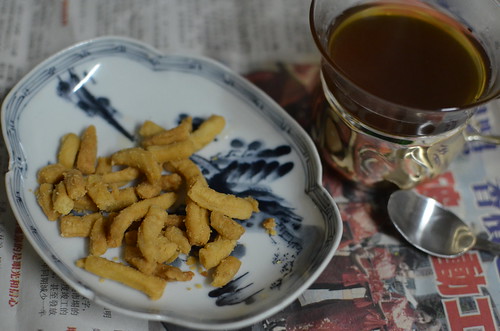

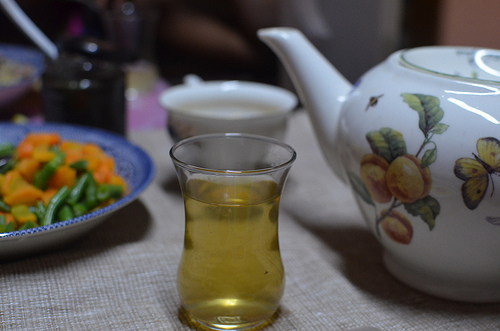


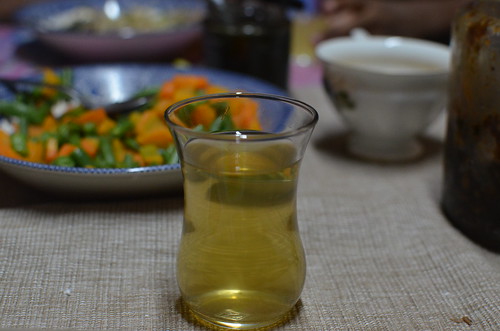
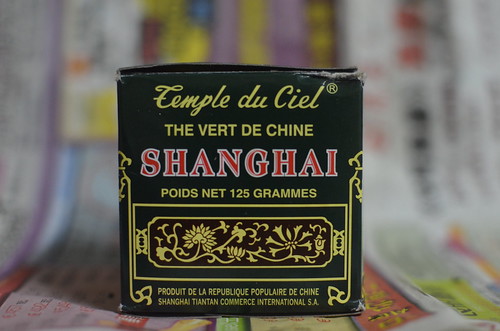

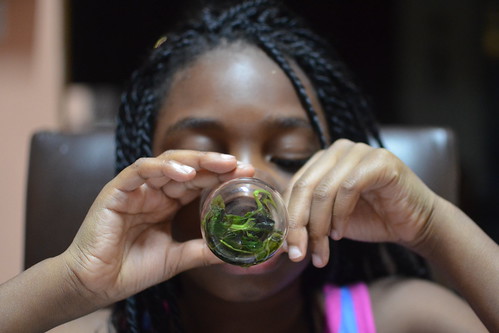
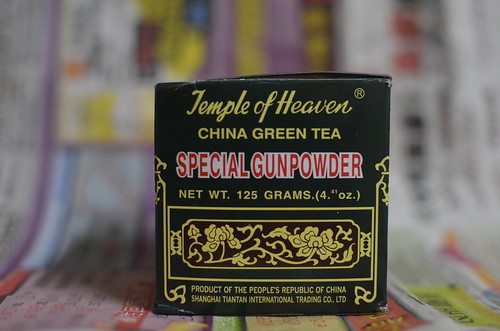
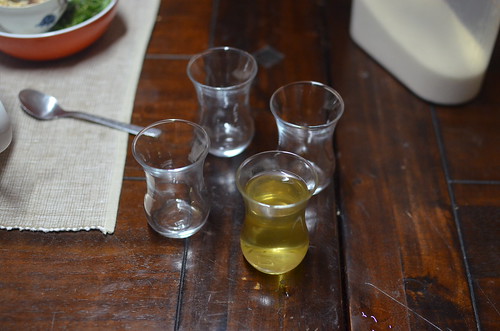
Leave a Reply